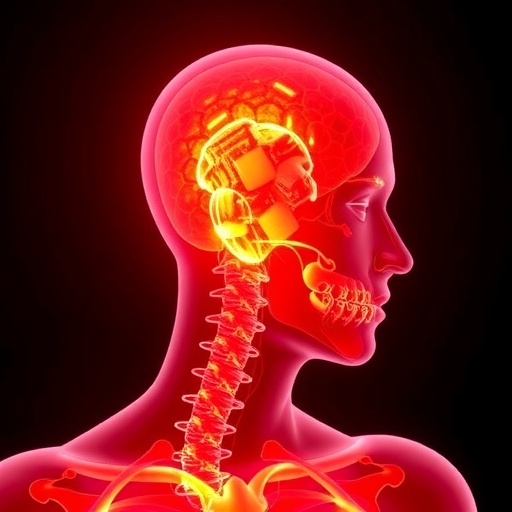In the intricate realm of cellular signaling and sensory biology, a groundbreaking study has unveiled a novel molecular mechanism that orchestrates how our bodies perceive painful heat. The research, recently published in Nature Communications, uncovers that histone lactylation—a relatively new form of epigenetic modification—plays a pivotal role in regulating a protein called DOCK4, which in turn controls heat nociception, or the sensory detection of harmful heat stimuli. Beyond its influence on sensory neurons, this pathway intriguingly supports the dynein motor complex-mediated trafficking of Nav1.7, a critical voltage-gated sodium channel intimately linked to pain perception. This discovery opens new horizons for understanding the molecular underpinnings of pain and may spark innovative therapeutic strategies targeting epigenetic regulation for chronic pain conditions.
Histone lactylation is an epigenetic mark first characterized within the past few years, representing an intersection of metabolism and gene regulation. Lactate, a metabolite historically viewed as a mere byproduct of anaerobic metabolism, has been redefined as a signaling molecule capable of modifying histones and influencing chromatin dynamics. In this context, researchers have elucidated that histone lactylation marks can modulate the transcriptional activity of certain genes involved in nociceptive pathways, specifically targeting the expression and regulation of DOCK4. DOCK4, a member of the dedicator of cytokinesis family, has emerged as a crucial molecular player coordinating cytoskeletal reorganization and intracellular trafficking, which are essential for the sensitization of heat-sensitive nociceptors.
The study employed rigorous molecular and cellular techniques to delineate how histone lactylation influences nociceptive neurons. Using advanced chromatin immunoprecipitation coupled with sequencing (ChIP-seq), the investigators mapped lactylation sites across the genome of dorsal root ganglion neurons exposed to noxious heat stimuli. They observed enriched lactylation marks near the promoter regions of the DOCK4 gene, correlating with increased transcriptional activity. This epigenetic activation appeared to heighten DOCK4 protein levels, amplifying downstream signaling events integral to neural sensitization and response to damaging heat.
Beyond transcriptional regulation, DOCK4’s role was further examined in the context of Nav1.7 channel trafficking. Nav1.7 is a voltage-gated sodium channel expressed predominantly in peripheral sensory neurons and is well-established as a critical determinant of pain sensitivity. Intracellular trafficking of Nav1.7 to the plasma membrane is a tightly controlled process necessary for its proper function. The researchers revealed that DOCK4 facilitates the interaction between Nav1.7-containing vesicles and the molecular motor complex dynein, which transports cargo along microtubules toward specific neuronal compartments. This dynein-mediated trafficking ensures the precise delivery and localization of Nav1.7 channels to the neuronal membrane, thereby modulating excitability and pain signal transmission.
Elucidating the link between histone lactylation, DOCK4 expression, and Nav1.7 trafficking provides significant insight into the dynamic regulatory mechanisms underlying thermal nociception. The researchers utilized knockdown and overexpression strategies to manipulate DOCK4 levels in vivo, observing corresponding changes in heat pain thresholds in murine models. Mice with suppressed DOCK4 expression demonstrated attenuated responses to noxious heat, underscoring the protein’s functional importance in nociceptive signaling pathways. Similarly, interference with dynein function disrupted Nav1.7 trafficking and reduced heat sensitivity, corroborating the proposed mechanistic model.
From a therapeutic vantage point, these findings carry considerable implications. Chronic pain affects millions globally, with heat hypersensitivity often observed in conditions such as neuropathies, inflammation, and certain genetic pain disorders. Targeting the epigenetic mechanisms that regulate key pain modulators like DOCK4 could pave the way for novel analgesic interventions. Unlike traditional treatments that broadly dampen neural activity or inflammatory responses, epigenetic modulators hold the promise of specificity, potentially minimizing side effects and long-term complications.
Moreover, the identification of lactate as a metabolic signal linking cellular energy states with pain perception opens an exciting interdisciplinary nexus between metabolism, epigenetics, and neurobiology. Such cross-talk suggests that cellular metabolic shifts, perhaps due to injury or disease, could remodel chromatin landscapes in sensory neurons, dynamically tuning pain sensitivity in response to the organism’s internal and external milieu. This metabolic-epigenetic axis introduces a fresh paradigm into the understanding of sensory plasticity and adaptation.
The study’s robust experimental design combined state-of-the-art genomic approaches with live imaging and behavioral assays, demonstrating the direct causal relationship among histone lactylation, DOCK4 expression, dynein-mediated Nav1.7 trafficking, and heat nociception. This comprehensive approach lends strong credibility to the assertions and sets a solid foundation for future investigations to explore related epigenetic modifications or parallel pathways influencing other sensory modalities.
Interestingly, this line of inquiry also intersects with pain genetics and channelopathies, as mutations in Nav1.7 have been implicated in rare human pain disorders characterized by insensitivity or extreme sensitivity to pain. The fine-tuned control of Nav1.7 trafficking by DOCK4 introduces a previously unrecognized regulatory layer, which may provide a molecular explanation for some of these phenotypes and underscore potential biomarkers for diagnostic and treatment stratification purposes.
Future research directions will likely focus on deciphering the full spectrum of genes regulated by histone lactylation in nociceptors and how systemic metabolic changes influence these epigenetic marks. Additionally, exploring the role of DOCK4 and Nav1.7 interactions in other pain modalities, such as mechanical or chemical nociception, might reveal broader physiological relevance. Pharmacological agents designed to modulate lactylation enzymes, or the molecular interfaces between DOCK4 and the dynein complex, may emerge as innovative and targeted pain therapies.
In sum, this cutting-edge study elegantly illustrates how epigenetic modifications born from metabolic signals can dictate pain sensitivity through finely tuned neuronal protein trafficking. The convergence of histone lactylation, DOCK4 function, and dynein-mediated movement of Nav1.7 channels represents a landmark advancement in sensory neurobiology, offering fresh conceptual frameworks and therapeutic potential in the age-old battle against pain.
Subject of Research: Regulation of heat nociception via epigenetic histone lactylation, involving DOCK4 and dynein-mediated Nav1.7 trafficking in sensory neurons.
Article Title: Histone lactylation regulates DOCK4 to control heat nociception and supports Dynein-mediated Nav1.7 trafficking.
Article References:
Xie, MX., Lai, RC., Xiao, YB. et al. Histone lactylation regulates DOCK4 to control heat nociception and supports Dynein-mediated Nav1.7 trafficking.
Nat Commun 16, 7165 (2025). https://doi.org/10.1038/s41467-025-62343-3
Image Credits: AI Generated




